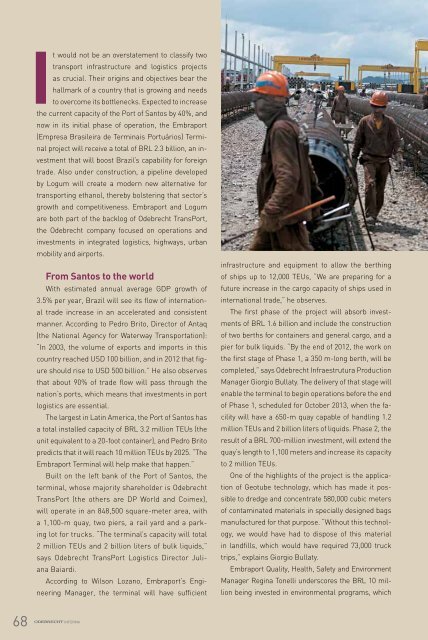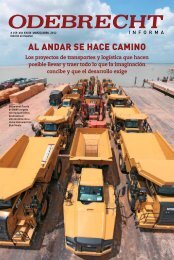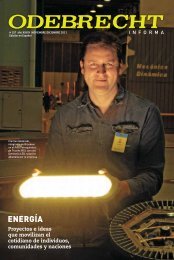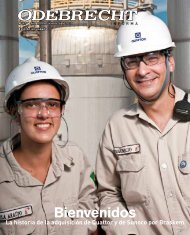THIS IS HOW THE PATH IS BUILT - Odebrecht Informa
THIS IS HOW THE PATH IS BUILT - Odebrecht Informa
THIS IS HOW THE PATH IS BUILT - Odebrecht Informa
Create successful ePaper yourself
Turn your PDF publications into a flip-book with our unique Google optimized e-Paper software.
It would not be an overstatement to classify two<br />
transport infrastructure and logistics projects<br />
as crucial. Their origins and objectives bear the<br />
hallmark of a country that is growing and needs<br />
to overcome its bottlenecks. Expected to increase<br />
the current capacity of the Port of Santos by 40%, and<br />
now in its initial phase of operation, the Embraport<br />
(Empresa Brasileira de Terminais Portuários) Terminal<br />
project will receive a total of BRL 2.3 billion, an investment<br />
that will boost Brazil’s capability for foreign<br />
trade. Also under construction, a pipeline developed<br />
by Logum will create a modern new alternative for<br />
transporting ethanol, thereby bolstering that sector’s<br />
growth and competitiveness. Embraport and Logum<br />
are both part of the backlog of <strong>Odebrecht</strong> TransPort,<br />
the <strong>Odebrecht</strong> company focused on operations and<br />
investments in integrated logistics, highways, urban<br />
mobility and airports.<br />
From Santos to the world<br />
With estimated annual average GDP growth of<br />
3.5% per year, Brazil will see its flow of international<br />
trade increase in an accelerated and consistent<br />
manner. According to Pedro Brito, Director of Antaq<br />
(the National Agency for Waterway Transportation):<br />
“In 2003, the volume of exports and imports in this<br />
country reached USD 100 billion, and in 2012 that figure<br />
should rise to USD 500 billion.” He also observes<br />
that about 90% of trade flow will pass through the<br />
nation’s ports, which means that investments in port<br />
logistics are essential.<br />
The largest in Latin America, the Port of Santos has<br />
a total installed capacity of BRL 3.2 million TEUs (the<br />
unit equivalent to a 20-foot container), and Pedro Brito<br />
predicts that it will reach 10 million TEUs by 2025. “The<br />
Embraport Terminal will help make that happen.”<br />
Built on the left bank of the Port of Santos, the<br />
terminal, whose majority shareholder is <strong>Odebrecht</strong><br />
TransPort (the others are DP World and Coimex),<br />
will operate in an 848,500 square-meter area, with<br />
a 1,100-m quay, two piers, a rail yard and a parking<br />
lot for trucks. “The terminal’s capacity will total<br />
2 million TEUs and 2 billion liters of bulk liquids,”<br />
says <strong>Odebrecht</strong> TransPort Logistics Director Juliana<br />
Baiardi.<br />
According to Wilson Lozano, Embraport’s Engineering<br />
Manager, the terminal will have sufficient<br />
infrastructure and equipment to allow the berthing<br />
of ships up to 12,000 TEUs, “We are preparing for a<br />
future increase in the cargo capacity of ships used in<br />
international trade,” he observes.<br />
The first phase of the project will absorb investments<br />
of BRL 1.6 billion and include the construction<br />
of two berths for containers and general cargo, and a<br />
pier for bulk liquids. “By the end of 2012, the work on<br />
the first stage of Phase 1, a 350 m-long berth, will be<br />
completed,” says <strong>Odebrecht</strong> Infraestrutura Production<br />
Manager Giorgio Bullaty. The delivery of that stage will<br />
enable the terminal to begin operations before the end<br />
of Phase 1, scheduled for October 2013, when the facility<br />
will have a 650-m quay capable of handling 1.2<br />
million TEUs and 2 billion liters of liquids. Phase 2, the<br />
result of a BRL 700-million investment, will extend the<br />
quay’s length to 1,100 meters and increase its capacity<br />
to 2 million TEUs.<br />
One of the highlights of the project is the application<br />
of Geotube technology, which has made it possible<br />
to dredge and concentrate 580,000 cubic meters<br />
of contaminated materials in specially designed bags<br />
manufactured for that purpose. “Without this technology,<br />
we would have had to dispose of this material<br />
in landfills, which would have required 73,000 truck<br />
trips,” explains Giorgio Bullaty.<br />
Embraport Quality, Health, Safety and Environment<br />
Manager Regina Tonelli underscores the BRL 10 million<br />
being invested in environmental programs, which<br />
informa<br />
68
















